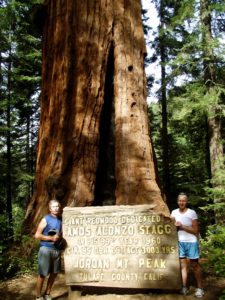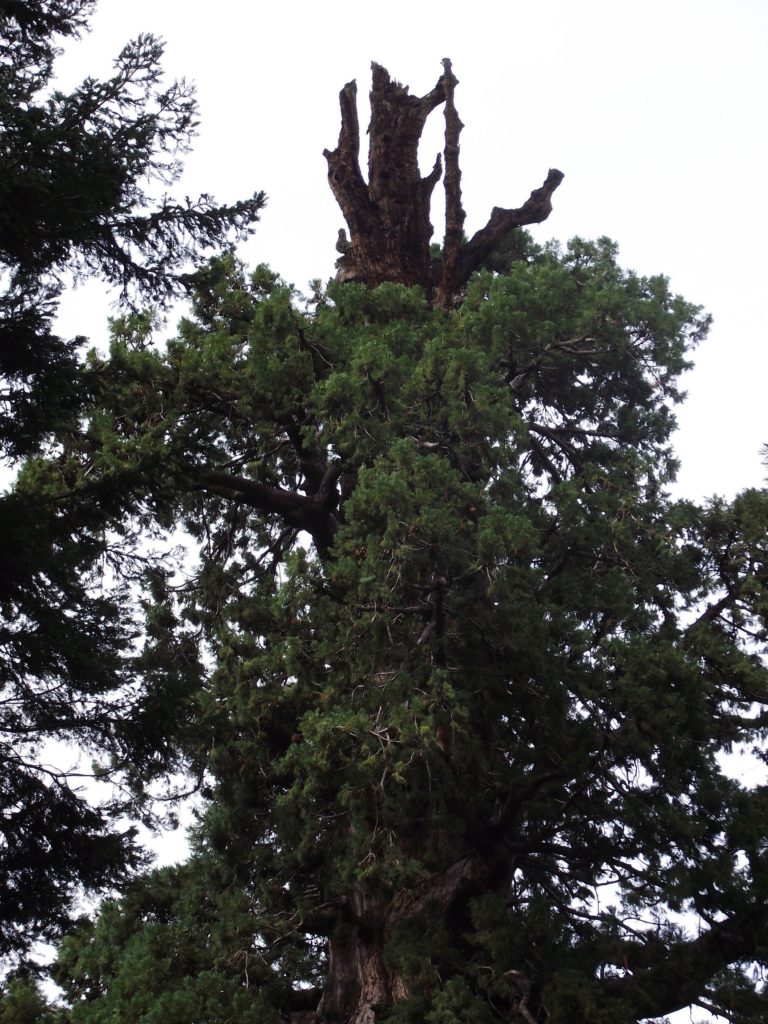The planet’s 5th largest tree by volum was named in 1960 for Amos Alonzo Stagg (1862-1965), a college football coach.
By Sarah Elliott, 7 October 2019, 3RNews
 The fifth largest tree on the planet is the Amos Alonzo Stagg Tree. It is also the largest tree outside of Sequoia and Kings Canyon National Parks and has had the distinction of being the largest tree in the world that is located on private land. (But, perhaps, not for much longer. The Rouch family sold the Alder Creek Grove to Save the Redwoods League.)
The fifth largest tree on the planet is the Amos Alonzo Stagg Tree. It is also the largest tree outside of Sequoia and Kings Canyon National Parks and has had the distinction of being the largest tree in the world that is located on private land. (But, perhaps, not for much longer. The Rouch family sold the Alder Creek Grove to Save the Redwoods League.)
The Stagg Tree is located off Highway 190 east of Springville.
To reach the Stagg Tree, drive east on State Highway 190 for 2.5 miles beyond Camp Nelson. Turn left on Redwood Drive (County Route M216) at the subdivision of Alpine Village and continue about 6 miles to the cabin community of Sequoia Crest. When Redwood Drive turns sharply left to become Alder Drive, drive straight ahead on the unpaved road for less than a half-mile to the locked gate.
From here, it’s less than a one-mile walk to the tree. Continue beyond the gate along an old logging road. Stay on this road as it passes through an old logging camp – with its unmistakable twin towers of giant sequoias – until reaching a short trail that is identified by a handmade sign pointing the way to the tree, which is a short walk downhill.
The land on which the Alder Grove grows is owned by the pioneer Rouch family. It is from this grove that a 25-foot-long block of downed giant sequoia wood was donated to sculptor Carroll Barnes of Three Rivers and during 1941-1942 was transformed into a statue of Paul Bunyan. The 20-foot tall, 13-ton statue has stood sentry at several Three Rivers locales and wandered as far as Porterville in southern Tulare County, but today calls Three Rivers Historical Museum home and greets all passersby on Sierra Drive.
This impressive carving has had several homes over the past 80 years, but today stands along Highway 198 in front of the Three Rivers Historical Museum. The sculpture is 17 feet tall, 9 feet wide, and weighs 13 tons.
The present-day owners of the Alder Creek Grove is the Rouch (pronounced ra-ow) family who are kind enough to grant public access so all may visit this fifth largest of all trees. (Be sure to follow all parking directions and refrain from smoking and littering.)
The Alder Creek Grove is about 785 acres and contains stands of young and mature sequoias. Although the Rouch family were loggers and developers throughout much of the 20th century, they never cut a giant sequoia.
When my husband, John, and I visited the tree, we were joined by two couples who were visiting from Russia. On our return hike we met other groups on pilgrimages to the tree.

The tree was named in 1960 for Amos Alonzo Stagg (1862-1965), immortalized college football coach whose career spanned 70 years. He also coached track, baseball, and basketball.
Stagg helped organize what is today the Big Ten Conference and is credited with many innovations in the game of football, from formations to uniforms and equipment. He was inducted into the College Football Hall of Fame as both a player and a coach.
According to measurements taken by Wendell Flint (To Find the Biggest Tree, 2002), the tree has reached a height of 244 feet and has a ground perimeter of 82.2 feet.
The Stagg Tree is on a steep slope, which makes it difficult to judge its true size. It has several burn scars and extremely thick bark.
Not only are sequoias the largest trees on earth, they are also the most enduring. Big Trees can live to be thousands of years old, mainly because they don’t usually die of natural causes.
The secret to this everlasting life is the giant sequoia’s outer bark, a fibrous, deeply furrowed, almost fur-like reddish-brown cortex. In the oldest of the trees, the outer bark can be up to two feet thick.
The leading cause of death for giant sequoias is fire. And in a complete contradiction, the giant sequoia also depends on fire for survival.
When the fuel of smaller trees such as pine and fir and accompanying forest shrubs build up the understory and encroach upon the Big Trees, a fire will burn with too much intensity, ultimately working through the sequoia’s protective outer bark to its thinner, more vulnerable inner bark.
Giant sequoias: The aging process
In contrast to a conflagration, occasional small fires burn away accumulated fuel. The sequoia seeds then germinate on the bare, mineralized soil.
A sprouting sequoia seed actually grows faster downward during the first several years of life, its taproot growing deep into the ground.
Above ground, through its adolescent years of a hundred years or so, the sequoia tree is conical with gray bark, blue-green foliage, and feathery limbs. A sequoia is fast-growing, adding about six feet per year.
As it ages, the trunk bares itself of branches and the needles turn greener. It’s only after a millennium or more that the tree’s bark turns to a cinnamon color and becomes deeply furrowed.
By then, its upper branches have grown as large as most trees. The largest will have jutted from the tree horizontally, as branches tend to do, but then form an elbow and grow skyward as if declaring their independence from the massive trunk.
The realm of massive trees once covered most of the Northern Hemisphere during an age of gigantic things. Although dinosaurs have long been extinct, the Big Trees continue to survive.
Today, giant sequoias have chosen to grow naturally only in groves located in the mid-elevations along the western slope of the Sierra Nevada Mountains.
We must never take these primeval trees for granted. Travelers from across the globe flock to see those that have chosen to grow so close to Three Rivers.
Update:
This article was originally published August 2011 in The Kaweah Commonwealth newspaper. Claud “Sonny” Rouch, 92 and then-patriarch of the Rouch family, corresponded upon learning of the feature. Sadly, Sonny died in February 2012 so my email conversations with him abruptly ended. Here are some of his insights from his original email:
Dear Sarah:
I’m told that your paper had a good article about the STAGG TREE. My family owns the land where that tree is located. There is a long and very interesting story which if you wish I will share it with you.
I have lived in Camp Nelson for over 50 years, My dad bought the land where the Stagg Tree is located in 1945. There was no road there at that time.
In the fall of 1945, coming home from service in the army, my first job was to build 6 miles of road to this full section of land which included the STAGG TREE. This area of Sequoias is named the South Alder Creek Grove.
We had a saw mill in Springville. Fortunately we didn’t cut the redwoods.
We then subdivided about 200 acres. This is now known as Sequoia Crest and there are now over 100 mountain homes built there.
This is enough for now. If you wish in the future I have a story of working for Disney in Mineral King. I worked for the Tulare County Road Dep. when the flood of 1969 took out the Kaweah Northfork road.
Sonny Rouch
